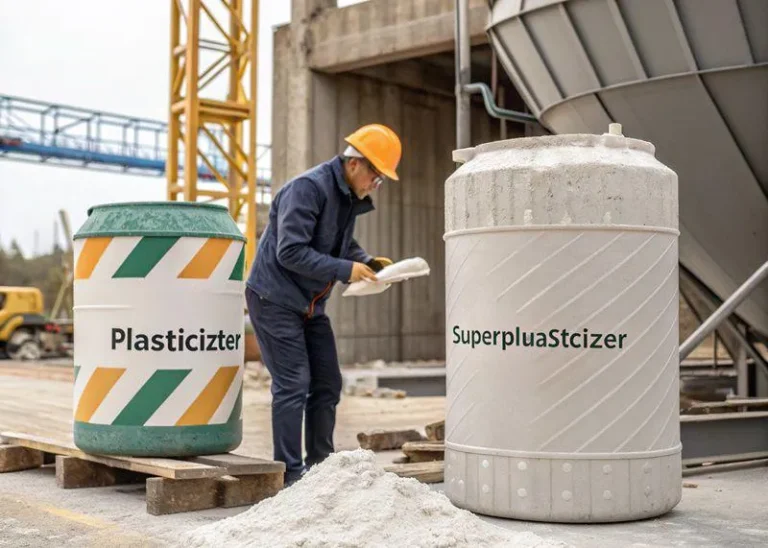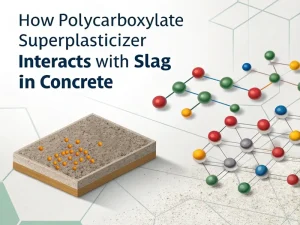Blog

In concrete, plasticizers are additives used to improve the workability of concrete mixtures while reducing the required amount of water. Plasticizers are typically based on lignosulfonates. These are waste products from wood pulp processing.
Lignosulfonate acts by adsorbing on the surface of cement particles. They are like lubricants between particles. Due to van der Waals forces, cement particles tend to naturally agglomerate. When water is added to form a cement slurry, these lumps will lock in the water, making the mixture difficult to process.
Plasticizers will decompose these clumps, allowing cement particles to move more freely relative to each other. This makes the concrete mixture more fluid and easier to manage, using less water and improving the overall workability of the concrete during mixing, pouring, and compaction processes.

Superplasticizer also known as a high-efficiency water reducer, is a relatively advanced concrete admixture. The most common high-efficiency water-reducing agent is based on polycarboxylates.
Polycarboxylate superplasticizers have a complex molecular structure. They have multiple functional groups and can strongly interact with cement particles. These additives are adsorbed on the surface of cement particles through electrostatic and chemical bonding mechanisms. Once adsorbed, they cause significant dispersion of cement particles.
Compared to plasticizers, this dispersion is more effective. The result is a significant reduction in the cement ratio while maintaining excellent workability, which is crucial for producing high-performance concrete.

Plasticizer: Plasticizers have a moderate water-reducing effect. Usually, they can reduce the moisture content in concrete mixtures by about 5-15%. This reduction is sufficient for many standard building projects, where basic improvements in operability and slight reductions in water usage are required.
For example, in small-scale residential construction projects, such as building standalone houses or constructing simple retaining walls, plasticizers can effectively make concrete easier to use without making the mix design too complex.
Superplasticizer: Superplasticizers are more effective in reducing water content. They can achieve a water reduction rate of 15-35%, and in some cases even higher. In large-scale infrastructure projects such as high-rise buildings, large-span bridges, and large industrial facilities, high-efficiency water-reducing agents are essential. These projects require high-strength and durable concrete.
The high water reduction efficiency of high-efficiency water-reducing agents allows for the production of very low water-cement ratio concrete, which is crucial for achieving the required strength and durability.
Plasticizer: Plasticizers improve the workability of concrete by making it more fluid. However, their impact on maintaining slump is relatively limited. With time after concrete mixing, the slump of concrete containing plasticizers often decreases at a relatively fast rate. This means that concrete containing plasticizers needs to be used relatively quickly after mixing.
For example, suppose there is a delay in transporting concrete from the mixing plant to the construction site. In that case, the workability of the concrete treated with plasticizers may be significantly reduced, making it more difficult to properly place and compact.
Superplasticizer: Superplasticizers not only provide high initial processability but also have excellent slump retention performance. They can keep concrete usable for a longer period of time. In the operation of ready-mixed concrete, concrete may require long-distance transportation or short-term storage before use, and superplasticizers are an ideal choice. They ensure that the concrete remains in a working state before reaching the point of use, thereby reducing the risk of the concrete becoming too hard to be effectively poured or compacted.
Plasticizers: By reducing the water-cement ratio to a certain extent, plasticizers do help improve the strength of concrete. However, due to its relatively low water-reduction efficiency, the improvement in strength is not as significant as that of high-efficiency water-reducing agents. In terms of durability, moderately reducing the moisture content helps to make concrete denser, thereby improving its resistance to environmental factors such as water infiltration.
However, compared to concrete treated with high-efficiency water-reducing agents, its durability enhancement is relatively limited. For example, on concrete lanes primarily exposed to normal weather conditions, concrete treated with plasticizers can be well preserved. Still, in more adverse environments, its performance may degrade faster than concrete treated with superplasticizers.
Superplasticizer: Superplasticizers significantly reduces the water-cement water-cement ratio, thereby improving the strength of concrete. The denser structure formed also makes concrete highly resistant to various environmental factors. It is more resistant to chemical erosion, such as chlorides in marine environments or sulfates in soil. The enhanced durability of concrete treated with high-efficiency water-reducing agents makes it an ideal choice for structures that need to withstand harsh conditions for a long time, such as offshore oil platforms, which are often exposed to seawater and harsh weather.
Plasticizers: Plasticizers are usually more cost-effective. Their production process is relatively simple. Raw materials such as wood pulp waste used for lignosulfonates can be widely obtained at a lower cost. For small projects with limited budgets or projects with low-performance requirements, plasticizers can provide a good balance between cost and performance.
For example, in small DIY concrete projects or small-scale agricultural construction projects around houses, plasticizers may be an economically efficient choice.
Superplasticizer: Superplasticizers are more expensive. Their complex chemical synthesis and use of high-quality raw materials result in higher costs. However, in large-scale, high-value projects where performance requirements are crucial, the advantages of high-efficiency water-reducing agents in terms of strength, durability, and ductility often outweigh cost differences.
In the construction of large airports, concrete runways need to withstand heavy aircraft loads and harsh weather conditions for a long time. The use of superplasticizers is reasonable because, from the perspective of reducing maintenance and replacement costs, it can save costs in the long run.
Plasticizers and Superplasticizer have their own characteristics and advantages in concrete applications. Plasticizers are low-cost and suitable for small projects with relatively basic requirements for concrete performance and a limited budget, which can effectively improve construction convenience. Superplasticizer have become the preferred choice for large-scale infrastructure and construction projects in harsh environments due to their excellent water reduction efficiency, outstanding slump retention, significant strength enhancement, and durability improvement effects.
In practical engineering, engineers and construction personnel need to comprehensively consider factors such as project scale, budget, performance requirements, and environmental conditions and carefully select suitable additives. Sometimes, the two are used in combination according to specific needs to achieve optimal concrete performance and economic benefits. By selecting and using plasticizers and high-efficiency plasticizers reasonably, concrete can be better utilized in various construction scenarios, helping the construction industry achieve high-quality and sustainable development.

How Polycarboxylate Polyether Monomer Affect Concrete Performance
Blog How Polycarboxylate

How Polycarboxylate Superplasticizer Interacts With Slag In Concrete
Blog How Polycarboxylate